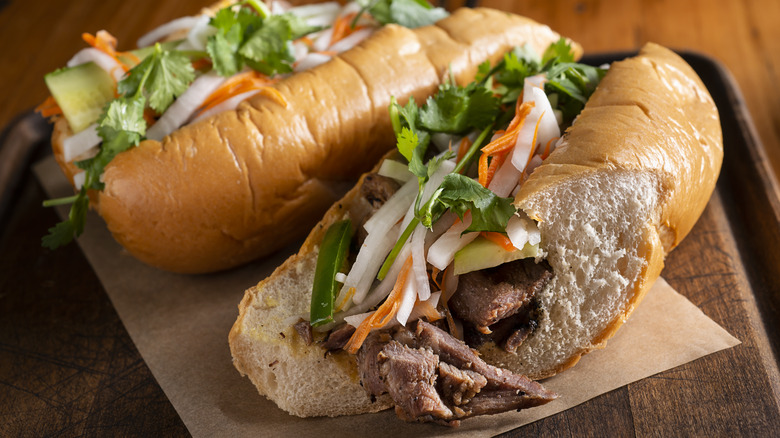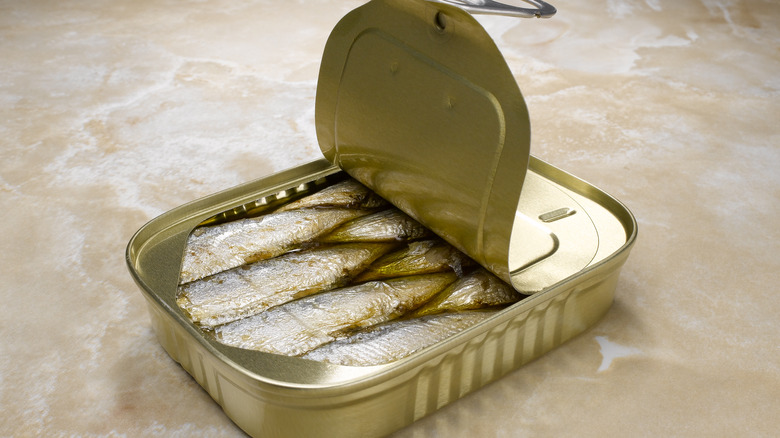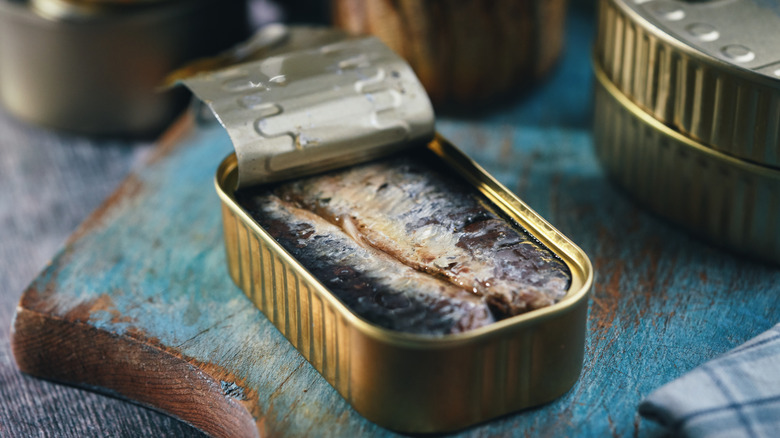Canned Sardines Make For A Delectable Banh Mi In A Pinch
The bánh mì is a staple in Vietnamese cuisine — simple to make but easily customizable. The sandwich features meat of your choice and veggies like pickled daikon, cucumber, carrots, and cilantro on French baguette bread. The sandwich is topped with mayonnaise for a creamy finish. While you can make bánh mì with fresh fish, canned sardines add a salty flair to the sandwich. Plus, they're convenient if you want to make a quick and easy but fulfilling sandwich.
Canned sardines stand out among the various proteins you can choose for the sandwich such as chicken, meatballs, or even pork. There's a historical element with Vietnamese people having a long history with canned sardines, which we will get to in a minute. For Vietnamese immigrants, the sandwich is a reminder of home, and for others, it's a tasty snack. The saltiness of the canned fish pairs well with the sourness of pickled veggies like the aforementioned daikon. The heartiness of the fish contrasts well with vegetables, so much so that people often throw canned sardines in a salad. The fish adds an additional flavor and depth to the meal, without sticking out or seeming out of place with the other elements of the sandwich. The preferred type of sardines for this sandwich are the kind soaked in tomato sauce because you get that sweet hint of tomatoes to further bring things together.
Fresh sardines vs canned sardines
You may tempted to use fresh sardines in your bánh mì sandwich because fresh is always better, right? While it's true that fresh ingredients, including sardines, typically have a higher quality, the dish has historically been made using canned sardines. So if you want a more authentic sandwich, then it's better to grab a couple cans of sardines for your bánh mì.
Generally, if you're using fresh sardines then your sandwich will have a different taste. Fresh sardines have a less potent fish taste and are generally sweeter than the canned variety. While that may make for a more pleasant dining experience if you were eating the fish straight up, there's a risk of fresh sardines not standing out among the other ingredients of your sandwich. In comparison, canned sardines have a stronger salty taste.
Additionally, canned sardines are more convenient if you're trying to make a bánh mì or perhaps a fish taco in a pinch. You don't have to worry about the hassle of cooking them before you prepare your sandwich. Fresh sardines can be difficult to find unless you have a fish market in your town. Likewise, they typically don't last long unless frozen. Comparatively, canned sardines can last a lot longer in your pantry.
History of canned sardines in Vietnam
As mentioned above, the Vietnamese have a somewhat conflicted history when it comes to canned sardines. The French originally introduced the canned fish to the country in the early 1900s. With the process for canning becoming available in the 1800s, canned sardines became a staple for the lower classes in France. At the time, Vietnam was a French colony called Indochina, which it remained until 1954. The meal proved to be popular among colonists, often eaten in tomato sauce.
The meal also became a hit among the Vietnamese middle and upper class in the country. When France pulled out of Vietnam so did most of its import of canned sardines, but Vietnam started its own sardine canning company, Ha Long Canfoco. For immigrants who left Vietnam during the height of the Vietnam War, canned sardines took on a strong association with their homeland but also difficult times. Vietnamese immigrants ended up in refugee camps waiting for passage into another country, and canned sardines were a common meal for these refugees.
Still, many of these immigrants enjoyed the taste of canned sardines in the years afterward. They took the recipe for the canned sardine bánh mì sandwich with them, passing it down to their families.


